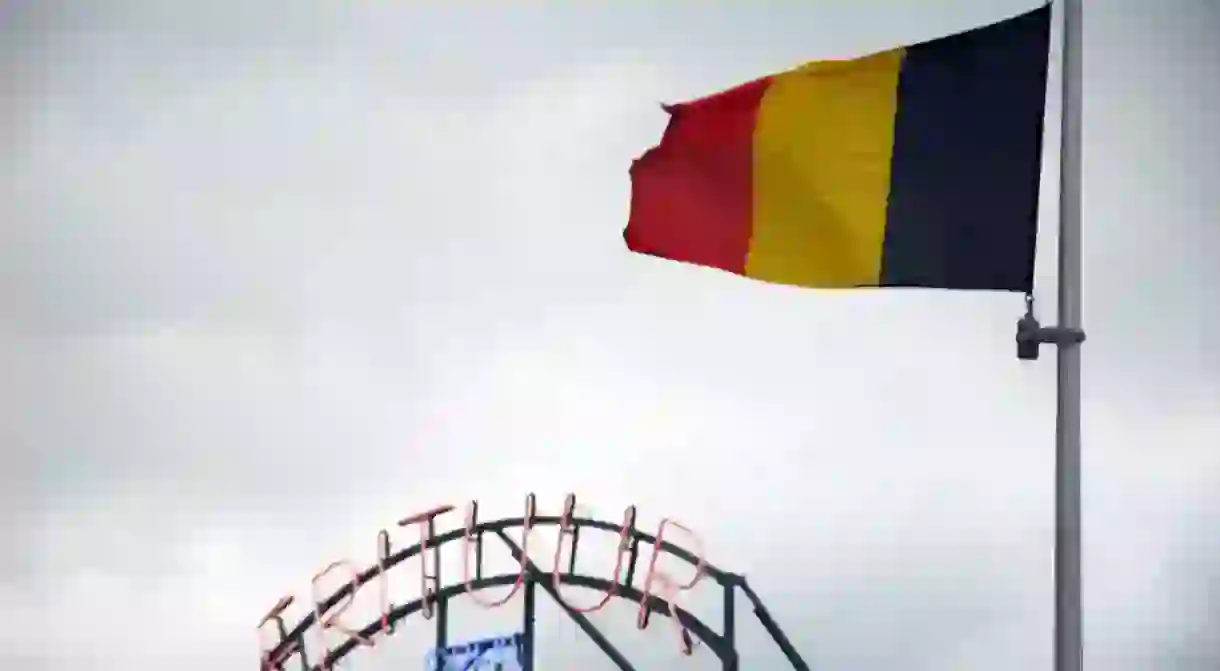12 Cool Facts About the Belgian Flag

In all its black, yellow and red glory, the Belgian flag is both a symbol of independence and an object of confusion. For example, what is up with its occasional squat posture, and why is it sometimes covered in gold fringe? We divulge 12 fun facts about Belgium’s tricolour.
A symbol of independence
Before Belgian independence became fact in 1831, the region’s unofficial flag boasted the same colours that it does now, only its bands were horizontal. The modern vertical layout was first used during the Belgian Revolution to indicate a turning on its head of the status quo and to express a fierce will for independence.

The only flag in the world to defy its Constitution
‘The Belgian nation chooses for its colours red, yellow, and black,’ the country’s Constitution details. But the current flag doesn’t actually follow that pattern: it goes black, yellow and red instead. This layout would mean Belgians have been accidentally turning their flag upside down for over 180 years – except that lawmakers firmly decided that for aesthetic and heraldic reasons the black part should sit next to the flagpole. Lawmakers simply never thought it was worth the hassle to go through the complicated process of amending the Constitution. When Member of Parliament Louis Standaert suggested fixing the aberration in the 90s, the proposition caused merriment before quickly being dismissed.
A confusing start
For the first years of Belgium’s existence, horizontal and vertical flags still existed alongside each other. Due to the infamous Article 193 of the Constitution, the exact colour order got regularly switched up as well, especially in the very beginning. Legend even has it that Belgian troops accidentally fired at their own because, due to a lot of smoke, they confused their flag with the red band on top for the Dutch one.
Good rebels got an Honour Flag
In September of 1832, a newly minted Congress sought to reward volunteer groups and towns that had bravely fought for Belgian independence. Consequently, King Leopold I stood on Place Royale and handed out Honour Flags to delegates from a hundred towns and municipalities. These ornate copies had horizontal bands, a tricolour fringe around the edge and the year 1830 in the middle, surrounded by a golden garland. Underneath the laurels, it said ‘La Patrie Reconnaisante’, or ‘The Grateful Homeland’. The one gifted to Luxembourg is now in the Royal Military Museum, where it is still on display.
Humility, fortune, and victory
It’s well known that Belgians are firm believers in the value of modesty, even for those who have known great riches and victory. Its flag says as much through its colours: black stands for humility, yellow represents riches and good fortune, and red symbolises victory – one that was well deserved after the revolution of 1830.

Inspired by an ancient coat of arms
There’s a second reason why the Belgian flag boasts the colours that it does, and that reason is the Duchy of Brabant. The coat of arms of the Duchy of Brabant, a province in the Low Countries with a formidable past as a region of power, inspired the flag. Its arms showed a golden lion (yellow) on a black background with its claws and tongue out (red).
Strange dimensions
With 13:15 proportions, the constitutional Belgian flag is fairly unusual in size. Not quite a square yet not a rectangle either, Belgium’s tricolour looks like quite the squat fellow when hoisted above the Royal Palaces in Laeken. Flying atop public buildings, however, is the ‘civil’ version, which uses the more traditional 2:3 measurements. While the latter may appear more elegant, the plumper version apparently has an unexpected upside: it captures the wind in such a way that it’s less subject to wear and tear.
Festive in fringe
During parades, special flags with yellow fringe on three sides are often brought out to celebrate the occasion.

Know when the King is home and when it’s his birthday
On days when the nation’s ruling monarch is in the country (but not necessarily at home), a couple of particularly large flags are hoisted over the Royal Palaces in Brussels’ core and Laeken. On the days of the King’s and Queen’s birthdays, all flags go up in tribute as well.
Devilish popularity boost
The increasing prominence and success of the male national soccer team – the Red Devils – has been bringing new life to the national tricolour in recent years. You’ll never see as many flags hanging from window sills or black-yellow-and-red car mirror covers as you do during the UEFA Champions League or the FIFA World Cup.

Massive ship, tiny nation flag
The TI Asia tanker, built in South Korea, sails under the Belgian flag. The white mastodon for a time qualified as the largest ship in the world.
Flag desecration goes unpunished
Burning, trampling or otherwise tarnishing of the Belgian flag is any citizen’s right, as there are no laws in place forbidding it. There have been a couple of recorded instances of partition supporters (who vie for the split of Belgium into Flanders and Wallonia) in the 90s, but in general, flag-burning hasn’t been an issue in contemporary Belgium.













